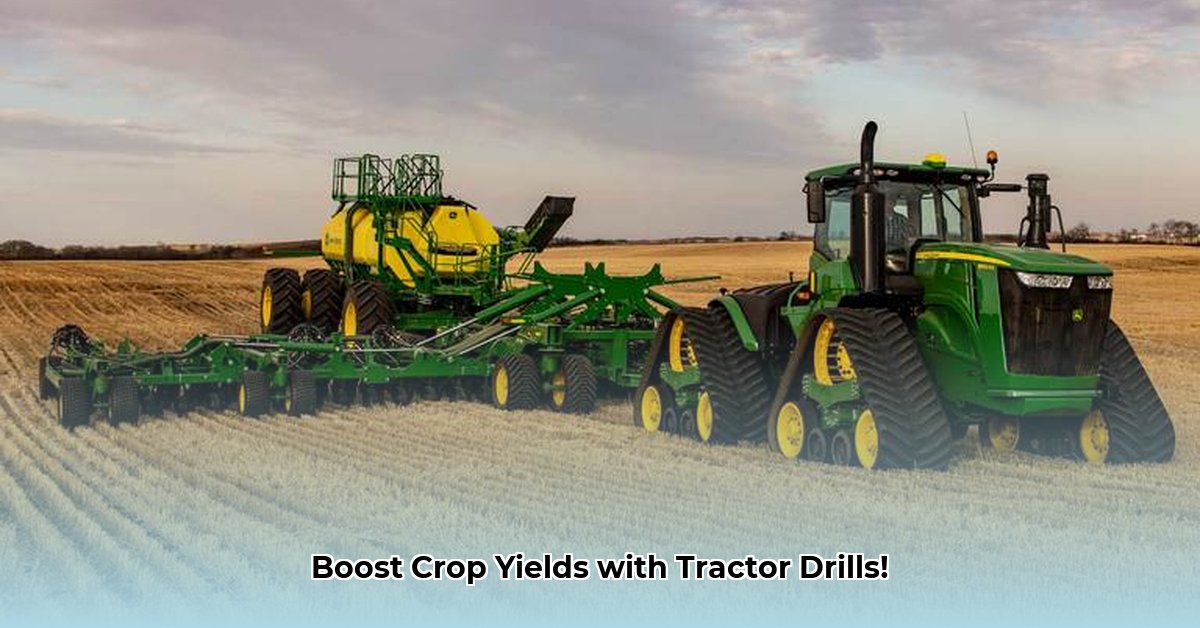
This comprehensive guide helps farmers select and effectively utilize grain drills for increased yields and sustainable agricultural practices. We'll explore different drill types, provide a decision-making framework, detail operation and maintenance, and examine the role of grain drills in environmental stewardship. For those using tractors, learn more about creating precise rows.
What's the Right Grain Drill for My Farm?
Choosing the right grain drill is crucial for maximizing yields and promoting soil health. The ideal choice depends on your farm's unique conditions and priorities. Let's explore the key types:
Conventional Drills: These reliable workhorses are suitable for tilled soil and offer a familiar, cost-effective option. However, they may not be ideal for minimizing soil disturbance.
No-Till Drills: Designed for planting directly into undisturbed soil, these drills are excellent for improving soil health, reducing erosion, and conserving water. They're particularly beneficial for environmentally conscious farmers.
Air Seeders: These precision instruments use compressed air for individual seed placement, ensuring even spacing. Air seeders are ideal for large farms and no-till farming, minimizing soil disturbance. Their precision minimizes seed waste and maximizes germination rates.
Don't forget to also consider factors such as your farm's size (small, medium, or large), soil type (heavy clay, sandy loam, etc.), and the crops you plan to plant (small seeds like alfalfa or larger seeds like corn). These variables will significantly influence your drill selection.
Choosing Your Perfect Drill: A Decision Tree
This decision tree streamlines the selection process:
Primary Farming Practice: Conventional tillage or no-till? No-till points towards a no-till drill.
Farm Size: Small farms may benefit from mounted drills for maneuverability, while larger operations may require pull-type drills for efficiency.
Soil Conditions: Heavy clay soils require drills with aggressive coulters, whereas lighter soils may accommodate lighter-duty models.
Crop Type: Seed size and shape impact the required seed spacing and planting depth.
Budget: Your budget will significantly constrain your options.
This framework helps clarify your needs and provides direction in choosing the most suitable drill for your farm. If further assistance is needed, consult with agricultural experts or experienced farmers in your region.
Operating and Maintaining Your Grain Drill: A Step-by-Step Guide
Proper operation and maintenance are paramount for optimal performance and longevity.
Calibration: Precise calibration ensures consistent seed spacing and depth, directly impacting germination rates and yield. Improper calibration can lead to wasted seeds and uneven crop growth.
Setup: Adjust the drill settings to match your chosen seed type and soil conditions (depth, pressure, etc.). Incorrect settings can severely impact planting accuracy.
Operation: Maintain consistent speed and depth during planting for optimal seed placement and germination. Uneven operation can result in inconsistent plant spacing and yield.
Maintenance: Regularly clean, lubricate moving parts, and inspect for wear and tear to prevent breakdowns and ensure continued precision. This proactive approach reduces repair costs and downtime.
Troubleshooting: Familiarize yourself with common issues (e.g., seed flow problems, uneven planting) and their solutions, as detailed in your drill’s manual.
Sustainability: The Long-Term View
Grain drills are instrumental in sustainable agriculture, offering several key environmental benefits:
Reduced Soil Erosion: No-till practices significantly minimize soil erosion, preserving valuable topsoil and improving water retention. This leads to healthier soil and potentially higher yields over time.
Less Seed Waste: Precise seed placement minimizes seed waste, representing both cost savings and reduced environmental impact.
Improved Soil Health: Reduced tillage improves soil structure, promotes biodiversity, and enhances water infiltration. This contributes to healthier crops and more sustainable farming practices.
While the benefits are substantial, continuous research is essential to fully understand the long-term environmental impacts of various drilling techniques and technologies.
The Future of Precision Planting: Technological Advancements
Precision agriculture is transforming grain drill technology:
Variable Rate Seeding: This technology adapts seeding density based on real-time soil conditions, optimizing resource use and maximizing yield potential.
Smart Sensors: Real-time data on planting depth, seed spacing, and soil conditions allows for immediate adjustments, enhancing precision and efficiency.
Automated Steering: Automated guidance systems ensure precise seed placement even in challenging field conditions, leading to improved uniformity and yield.
These innovative technologies are reshaping sustainable agriculture, driving efficiency, profitability, and environmental responsibility.
Case Study: John's No-Till Success
John, a mid-sized farmer, transitioned to no-till farming using an air seeder. He experienced a 15% yield increase and marked improvements in soil health, resulting in reduced water and fertilizer use. His story showcases the potential for significant gains through sustainable agricultural practices and appropriate equipment choices.
Investing in the right grain drill is crucial for achieving both high yields and environmentally responsible farming. By carefully considering your farm's unique conditions and requirements, you can significantly enhance your productivity and contribute to a more sustainable agricultural future.